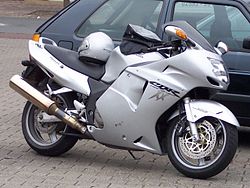 | |
| Manufacturer | Honda |
|---|---|
| Also called | Super Blackbird (1996–2007) |
| Production | 1996–2007 |
| Predecessor | CBR1000F Hurricane |
| Successor | none |
| Class | hyper sport |
| Engine | Type: 1137cc liquid-cooled inline four-cylinder Bore and Stroke: 79.0mm x 58.0mm |
| Power | 114 kW (153 hp) @ 10,000 rpm |
| Torque | 119 N·m (88 lb·ft) @ 7,250 rpm |
| Transmission | Close-ratio six-speed; Final Drive: #530 O Ring-Sealed Chain |
| Wheelbase | 1,490 mm |
| Dimensions | L 2,160 mm W 720 mm H 1,170 mm |
| Seat height | 810 mm |
| Weight | 227 kg (500 lbs) |
| Fuel capacity | 23 liter (including the 4 liter reserve) |
The Honda CBR1100XX Blackbird was the world's fastest production motorcycle when launched in the summer of 1996, surpassing the legendary Kawasaki ZX-11.Two years later the title had passed to the Suzuki Hayabusa.[citation needed] Nonetheless the Blackbird has earned a solid reputation as a powerful, fast, smooth and very reliable sport-touring motorcycle. The Blackbird name is a nod to the Lockheed SR-71 aircraft.
Production of the Blackbird began in 1996 and halted in late 2007.The Blackbird was last imported to North America in 2003. Major changes to the Blackbird were introduced in 1999, when Honda switched from carburetion to PGM fuel injection. Many other modifications were also made in 1999. The 2001 Blackbird received an LCD instrument cluster. Since then, only the color schemes have changed.
The Blackbird was a founding bike in the hyper sport touring niche market, along with the Kawasaki ZX-11. This market has since expanded to include the Suzuki Hayabusa and Kawasaki ZZR1400/ZX-14.In the US the CBR1100XX never sold as well as the Suzuki Hayabusa, although it is appreciated for its elegant lines and dual counter balancer shafts which give the Blackbird its exceptional smoothness.
Some of the 1999-2000 models have had their wiring looms replaced by Honda under warranty, this was due to corrosion around an unused "block connector". This connector is only used once to test the bike's electronics after manufacture and then simply taped up. Corrosion of this connector caused short circuits and a failure to run.
Specifications
- 1997
-
Engine Liquid-cooled 4-stroke 16 valve DOHC inline 4 Bore x Stroke 79 x 58 mm Displacement, 1137 cc Compression ratio 11:1 Fuel 91 octane unleaded gasoline Carburetors 42 mm slanted flat-slide CV x 4 Max. Power 121 kW (164 HP) @ 10,000 rpm Max. Torque 124 N·m @ 7,250 rpm Ignition Computer-controlled digital transistorised with electronic advance Starter Electric Transmission 6-speed close ratio gearbox Final drive 17 tooth front sprocket, 45 tooth sprocket (US) 530-110 'O'-ring sealed chain Dimensions (LxWxH) 2,160 x 720 x 1,170 mm Wheelbase 1,490 mm Seat height 810 mm Ground clearance 130 mm Fuel tank Capacity 23 L, including 4 L reserve Wheels Hollow-section triple-spoke cast Tires front Bridgestone BT 57 - 120/70 ZR17 Radial Rear Bridgestone BT 57 - 180/55 ZR17 Radial Suspension front 43 mm HMAS Cartridge-type fork, 120 mm travel Suspension rear Pro-link HMAS with gas-charged damper, rebound adjustable 120 mm travel Brakes front Linked Braking System, 310 mm dual disks with "dual combined" three-piston calipers Brakes rear Linked Braking System, 256 mm single disk with three-piston caliper Dry weight 223 kg (491 lb)
- 1998
- The water pump is changed. The other changes are minor.
- 1999
- Major update.
- PGM FI fuel injection system is introduced.
- Ram-air system is introduced. It provides engine with more air at high speeds (above 200 km/h) utilizing aerodynamic pressure, thus raising power output to a claimed 164 HP at 9500RPM (at the crank).
- Revised linked brakes with altered proportioning between front and rear.
- Fuel tank capacity is increased from 22 to 24 litres.
- The choke lever is removed from the left side switch assembly as it is no longer necessary.
- To accommodate the ram air tubes, the oil cooler becomes shorter and wider.
- The inner and outer fork bushings are wider, changing the fork lowers and sliders.
- The sidestand warning light on the instrument cluster becomes the FI warning light.
- The wide part of the front axle (left side) becomes 10mm longer, which makes the left-front axle space 10mm shorter.
- The two bulbs in the taillight are vertically aligned, in previous years they were side by side.
- Front wheel hub is enlarged, the brake rotors are changed.
- The ignition switch is changed. The 99+ keys are longer.
- The rotor carriers, stator cover and clutch cover are a light titanium color.
- The number of clutch plates is reduced from nine to seven.
- The rear inner fender changes shape to accommodate additional electronics.
- Only available in black, other colours like Red available in the european market.
- 2000
- No changes
- Only available in titanium in the USA, other colors such as candy blue available in other markets.
- 2001
- New dashboard now has a digital speedometer and other indicators, except tachometer, which is now in center of dashboard.
- Only available in Red in the USA, other colors available in other markets.
- 2002
- New EFI mapping to comply with emission standards and eliminate abrupt throttle response at low speeds.
- Only available in silver
- 2003
- Only available in black USA, other colors available in other markets.
- 2005
- Honda factory manual states fuel tank capacity is 23 litres.
- 2007
- Australian models receive ABS brakes and available in black.

0 comments:
Post a Comment